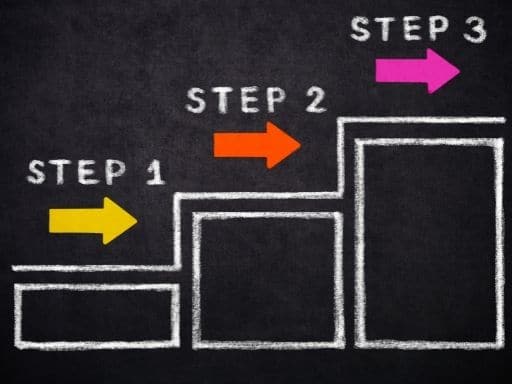
Put ten people in a room. Whisper a phrase with more than 10 words into the ear of the first person. The second person then relays the message to the third person. This process continues over and over until the phrase reaches the final person. When you compare the first message with the last message, they will be totally different.
This is what often happens when organizations try to implement a train-the-trainer model of employee development.
However, this doesn’t have to occur. If you put the right steps and processes in place, your employee development can be phenomenal. (It is also the best way to cut your training costs dramatically as well.)
By the way, if you are wanting to learn how to teach or learn how to become a great trainer, the Fearless Presentations ® class is a training course that teaches best practices for facilitation skills. It is one of the most effective ways to develop the practical skills of a master trainer. Click this link for details.
What is the Train-the-Trainer Model (TTT Model) and How is It Supposed to Work.
Very simply, the Train-the-Trainer Model is a training model where Subject Matter Experts (SME’s) are trained to develop other Subject Matter Experts. The acronym SME is often used in the technical realm. However, subject matter expertise exists in all industries.
When I was in High School, I got a job working in the mall at Chick-fil-a. On my first day there, they didn’t put me on the cash register. They put me in the back breading chicken and squeezing lemons for lemonade. The owner didn’t train me to do this. The manager didn’t train me to do this. A kid about my own age trained me. In fact, that kid had only been working there for about five months longer than me. However, he had been doing those particular jobs for the first month that he was there. So, he was a subject-matter expert on breading chicken and squeezing lemons.
In contrast, when I studied to be a presentation coach, I went through a more intense train-the-trainer process. I spent three years studying with a certified trainer (SME). During those three years, I dissected every module and co-taught modules with my mentor. Finally, an instructor-trainer flew in to certify me.
Both processes followed the Train-the-Trainer Model.
Key Steps to Create a Great Train-the-Trainer Course.
(1) Start by Creating Great Content and Training Materials.

Years ago, I had so many clients that I sometimes double-booked myself, so I hired an assistant to help me. My assistant had management experience, so she was used to having procedures written down in step-by-step processes. Since my processes, were all in my head, the lack of structure frustrated her. She and I spent the next couple of weeks writing down and refining the process. By doing so, we could measure the effectiveness of each step. We adjusted the process over and over to increase both efficiency and effectiveness. Within months, I was able to work with almost three times as many clients.
Eventually, I brought on new team members. Since I had already created the process, I could easily train these new team members.
(2) Efficiently Organize Your Content into a Simple, Step-by-Step Process.

I’m currently training a new presentation coach. Because he has been a speaker for over a decade, he went through my class expecting to teach right away. I recently let him see the instructor manual for the first time. He was shocked at all the different steps that our instructors take in each session to ensure that our class members increase their confidence. We make it look really easy to the class members, but what our instructors are doing is very complex.
I explained to him that he and I would co-teach classes for the better part of a year. In each class, he’d start doing more and more of the process. So, every time we teach a class together, he is mastering a different component of the process. Over time, he will have mastered all of the training sessions.
When you design your train-the-trainer model course, create a simple step-by-step process. If the process is complex, break it down into easily learnable bite-sized pieces.
(3) Test and Measure the Process.

In 1997, The Franklin Planner company merged with Stephen Covey’s leadership company. Since Covey taught time-management skills and Franklin sold day planners, it seemed like a sound merger. It didn’t work as expected, though. The new company created a train-the-trainer model to certify local trainers in every city. They had great content, but they didn’t test and measure the results of their trainer method.
My wife worked for a company that had quarterly “Covey Training” sessions. She dreaded every one of them. I remember her saying, “I’m going to another Covey Training, next week. These things are a complete waste of my time.” (I always thought that was funny since she was attending time management classes.)
The company made a big mistake. They began to certify anyone who paid a small fee and attended a short train-the-trainer class. The people leading the sessions weren’t Subject Matter Experts. Since they never measured the results of the train-the-trainer model classes, they never knew. They just watched their stock price and market share drop year after year.
(4) People Learn by Doing. Add Activity/Application to Your Train-the-Trainer Model.

Years ago, I attended a marketing seminar here in Dallas. The organizers invited the participants to bring some of their marketing pieces to the seminar. As the speakers covered their curriculum, they had us recreate our marketing pieces. The program was very practical because we were actually re-designing items for our individual companies.
Another good example was with the Red Cross. I taught a presentation class for a group of trainers in their blood bank. They were responsible for teaching their techs the SOP’s (Standard Operating Procedures). They were getting really poor results from their sessions. The technique that they used was to do a half-day of classroom training followed by lab time. I suggested that they spend just 10 to 20 minutes in the classroom teaching part of the process. Then, go into the lab to practice. After the practice, come back to the classroom. Then, go back to the lab. It worked much better.
Train Your Internal Trainers Using the Train-the-Trainer Model.
That last story leads us into the next step of the train-the-trainer model — the actual training process.
Good Presentation Skills are Essential to the Train-the-Trainer Model.

Remember that being a great public speaker is not a natural gift. It is a skill. This skill takes time to develop. When helping companies create or revitalize a train-the-trainer process, we almost always start here. If the Subject Matter Experts are confident and if they communicate well, the programs are always more effective. If the SME’s are poor communicators, the process will fail almost 100% of the time.
If your SMEs are not experienced trainers, you might consider adding platform techniques to their professional development.
For details about the specific communication skills to focus on, refer to 7 Qualities of a Great Public Speaker.
Develop Your Subject Matter Experts.
When you institute the train-the-trainer model within your organization, start small. Use the “fast food” model that I mentioned above. Have “Subject Matter Experts in Training” explain part of the process to a newer team member.
“Docendo Discimus (by teaching, we learn).” — Seneca
Over time, as your team members become more knowledgeable and skilled, increase their opportunity to teach. The technique that I use with my instructors is to have them start by watching me (or another instructor) teach a session. Next, give them a fun activity to lead while co-teaching with another instructor. Little by little, I increase their face-time in front of the group. In most cases, after they have developed good presentation skills, this learning happens fast.
Audit Both the SME’s and the Results of the Train-the-Trainer Model.
A big mistake that I made early on was not auditing my trainer’s classes. I assumed that since they spent over a year developing the train-the-trainer skill, the skill would be permanent. If you recall the telephone game that I described in the first part of this session, that is what can happen. I call divergence the “anomaly/snowball effect.”
An anomaly occurs. Most of the time, it is something really small. It is out of the ordinary and may never happen again. However, the trainer sees this anomaly as a problem with the way that the training session has occurred. As a result, he/she changes something slightly. The change then causes another challenge. Another adjustment is made. Every time a change is made that is outside of the original procedure, the divergence gets bigger and bigger. Over time, the SME isn’t following the outlined procedure from step one at all.
Before making changes to the process, it is a good idea to audit the programs to measure the effectiveness of the train-the-trainer process. This will ensure that critical skills are being properly taught to the next generation. The process you are using may be fine. The problem may be that you need to use corporate trainers with more teaching experience.
Effective training of your potential instructors will help you produce a more high quality learning process for your team.
Want to Create a Train-the-Trainer Program for your Organization?
Our expert facilitators can help you both create and implement a custom train-the-trainer program. Visit our page that describes a few of the Custom Corporate Coaching sessions available. You can also call us at 1-800-975-6151.

